The housing market is a hot topic right now, and for good reason. Over the past few years, home prices have soared, leaving many to wonder: Are we in the midst of a housing bubble, or is this just sustainable growth? The answer isn’t straightforward. While some see the rapid price increases as a warning sign, others argue that strong economic fundamentals are driving the market forward in a healthy way. The debate is ongoing, with experts weighing in from all sides. But what does this mean for you, the potential buyer, seller, or investor? Understanding the current landscape is crucial to making informed decisions.
source: Stuff on YouTube
Overview Of The Housing Market
The goal of this article is to help you navigate the complex world of real estate by identifying the key indicators that can signal whether the housing market is headed towards a bubble or if the growth we’re seeing is built on solid ground. We’ll dive into the signs that suggest a market bubble—think rapid price increases, low interest rates, and high levels of speculation. On the flip side, we’ll also explore the factors that point to sustainable growth, such as steady economic fundamentals, balanced supply and demand, and moderate price appreciation.
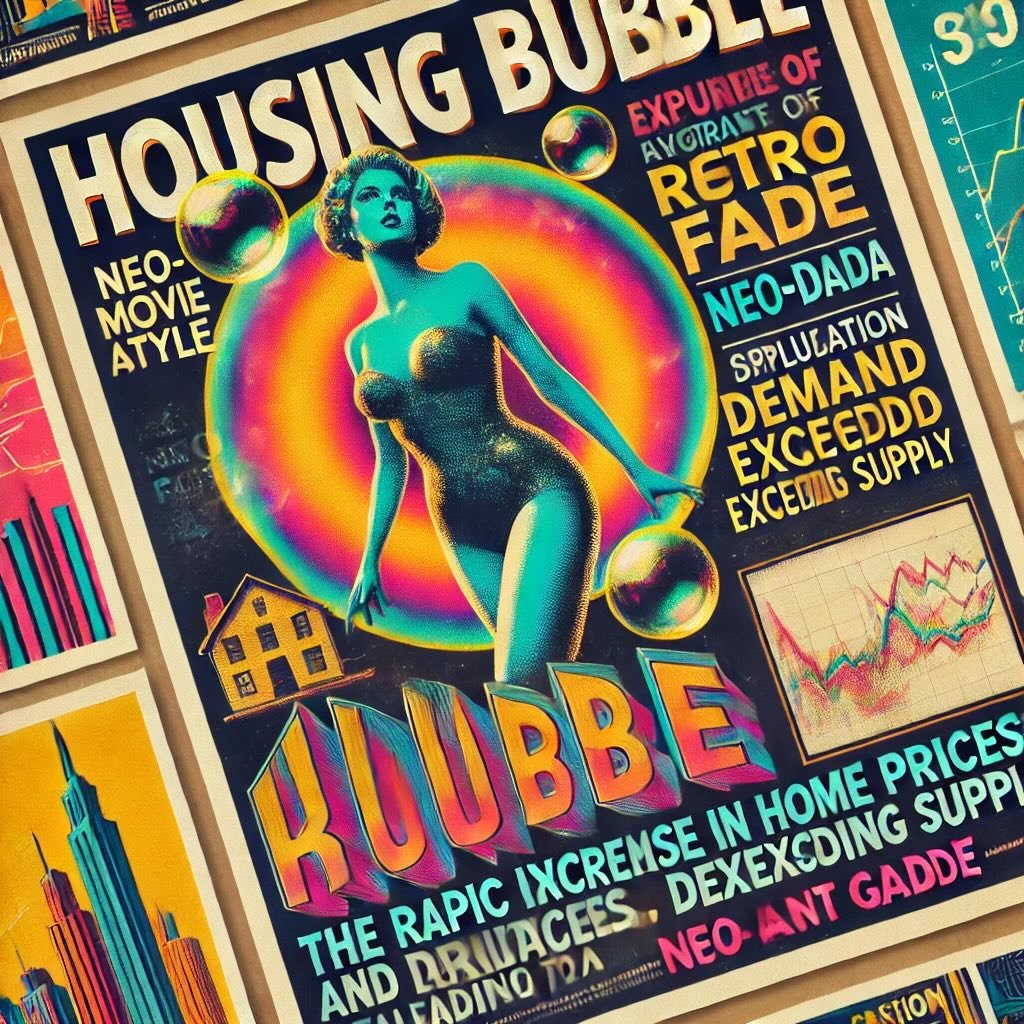
Understanding the Concept of a Housing Bubble
Definition of a Housing Bubble
A housing bubble is like an overinflated balloon—sooner or later, it has to pop. But what exactly is a housing bubble? In simple terms, a housing bubble occurs when home prices rise rapidly to levels that are unsustainable over the long term. These inflated prices are often driven by factors such as excessive demand, speculative buying, and easy access to credit. The key characteristic of a bubble is that the rise in home prices is not supported by underlying economic fundamentals, like income growth or employment rates.
How It Forms
A housing bubble typically begins with a surge in demand, often sparked by low interest rates or a booming economy. As more people rush to buy homes, prices start to climb. This, in turn, attracts speculators—buyers who aren’t interested in living in the homes but in flipping them for a quick profit. As speculation grows, prices soar even higher, creating a feedback loop of rising prices and increasing demand. However, this cycle can’t last forever. Eventually, something causes the bubble to burst—be it rising interest rates, tighter credit conditions, or simply the realization that prices have become disconnected from reality.
Historical Examples
To truly grasp the concept of a housing bubble, let’s look at some historical examples.
The 2008 Financial Crisis
The most infamous housing bubble in recent history is the 2008 financial crisis. During the early 2000s, the U.S. housing market experienced a dramatic boom. Home prices were skyrocketing, and everyone seemed to be getting into real estate. Banks were offering loans with little to no down payment, and even those with poor credit could get approved. This flood of easy money fueled speculative buying and led to an unsustainable rise in home prices.
By 2006, however, cracks began to appear. Housing prices started to plateau and soon after, they began to decline. Many homeowners found themselves “underwater,” meaning they owed more on their mortgages than their homes were worth. The situation worsened as many of these loans were adjustable-rate mortgages, which became more expensive as interest rates rose. The result was a wave of foreclosures, a collapse in home prices, and a financial crisis that rippled across the globe.
Other Examples
The 2008 crisis is a stark reminder of what can happen when a housing bubble bursts, but it’s not the only example. Consider Japan’s housing bubble in the late 1980s and the U.K.’s housing market crash in the early 1990s. Each of these cases highlights the dangers of unsustainable price increases in the housing market.
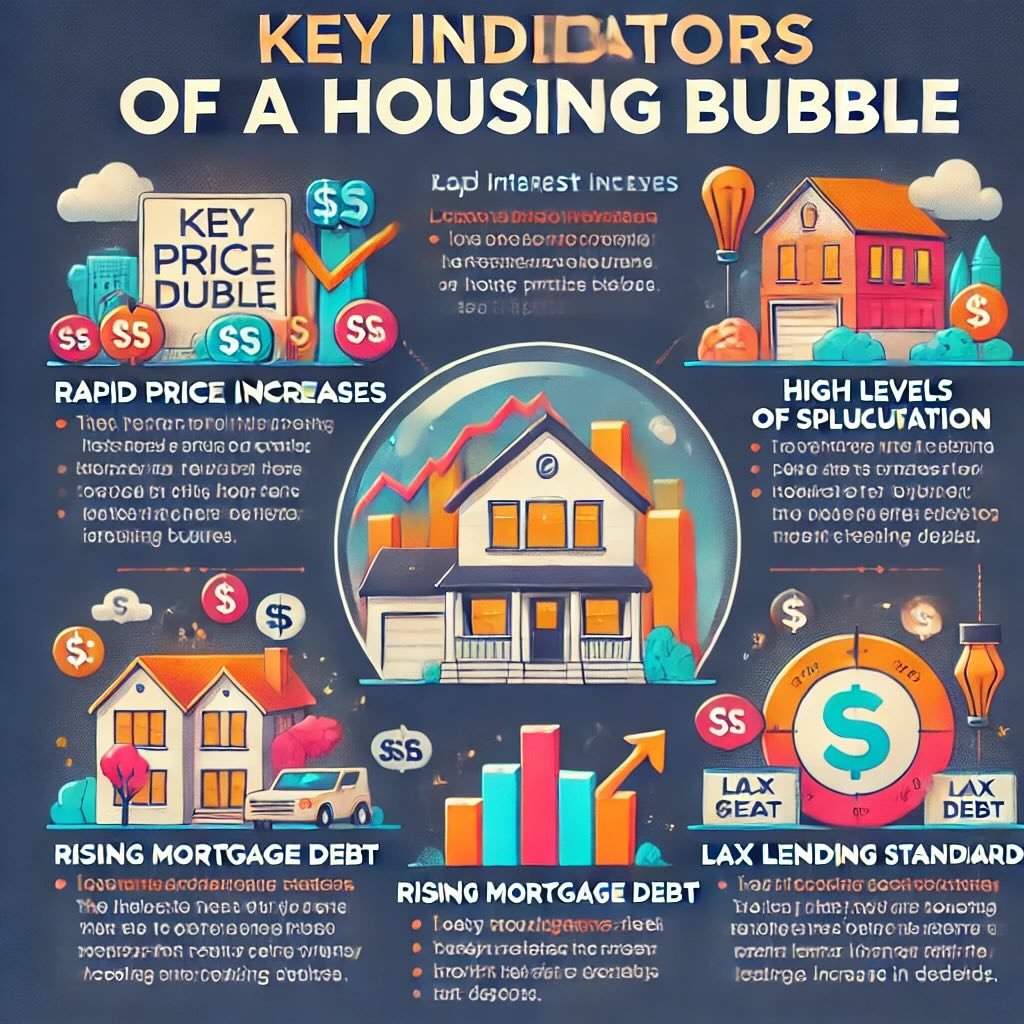
Key Indicators of a Housing Bubble
Rapid Price Increases
Unusually fast home price appreciation is often the first red flag of a housing bubble. When home prices start to rise at an accelerated pace, it’s usually a sign that demand is outpacing supply, sometimes to an unsustainable degree. In a healthy market, prices tend to increase gradually, in line with economic fundamentals like income growth and inflation. However, when prices soar rapidly, it suggests that buyers might be overextending themselves, driven by fear of missing out or speculation.
For example, in 2020 and 2021, certain markets across the U.S. saw home prices increase by double digits in a single year—a pace that far exceeded historical norms. Cities like Austin, Texas, and Boise, Idaho, experienced price growth of over 20% year-over-year. While some of this growth can be attributed to strong demand and limited supply, the speed and scale of the increases have raised concerns that these markets could be at risk of forming bubbles.
Low Interest Rates
Prolonged low interest rates are another key ingredient in the formation of housing bubbles. When borrowing becomes cheaper, more people can afford to take out larger mortgages, which in turn drives up demand for homes. This increase in demand can lead to rapidly rising home prices, especially in desirable markets. Low interest rates can also encourage speculative buying, as investors look to capitalize on the potential for quick gains in a rising market.
However, the downside of low interest rates is that they can create a false sense of security. Buyers may stretch their budgets to take advantage of lower monthly payments, but if interest rates rise, those same buyers could find themselves struggling to keep up with higher payments. The Federal Reserve has signaled potential rate hikes in the coming years, which could cool down overheated markets and expose the fragility of price gains driven by cheap credit.
High Levels of Speculation
Speculative buying is often a telltale sign that a housing market is overheating. When investors start snapping up properties not to live in, but to flip or rent out, it can inflate prices beyond what is justified by local economic conditions. This kind of activity can drive prices higher, as speculators compete with regular buyers, often pushing them out of the market.
House flipping is one clear indicator of speculation. In some markets, the percentage of homes purchased by investors has soared. For instance, in the first half of 2021, investors made up more than 15% of all home purchases in certain markets, a level not seen since the last housing bubble. When a significant portion of the market is driven by speculation rather than actual demand for housing, it increases the risk of a bubble forming.
Rising Mortgage Debt
The growth in mortgage debt is another warning sign of a potential housing bubble. As home prices rise, buyers often take on larger mortgages to afford their purchases. While some level of mortgage debt is normal, a sharp increase in borrowing can indicate that buyers are stretching themselves too thin. This is especially concerning if the growth in mortgage debt outpaces income growth, as it suggests that borrowers might struggle to meet their payments if the economy takes a downturn.
In recent years, mortgage debt in the U.S. has climbed to record levels, surpassing the peak reached before the 2008 financial crisis. This surge in borrowing raises concerns that many buyers could be overextending themselves, particularly in markets where home prices have soared. If the economy were to slow down or interest rates were to rise, these borrowers could find themselves in financial trouble, potentially leading to a wave of defaults.
Lax Lending Standards
Lax lending standards can significantly contribute to the formation of a housing bubble. When banks and other lenders lower their requirements for mortgage approval, more people can qualify for loans, even those who may not be financially prepared to take on large amounts of debt. This influx of new buyers can drive up home prices, but it also increases the risk of defaults down the line, as borrowers may struggle to make their payments.
During the lead-up to the 2008 financial crisis, lending standards became notoriously lax, with practices like no-doc loans (where borrowers didn’t have to provide documentation of their income) and adjustable-rate mortgages with teaser rates that eventually reset to much higher levels. While lending standards today are generally stricter than they were back then, there are still signs of easing. For example, some lenders are now offering higher loan-to-value ratios or lower down payment requirements, which could encourage more risky borrowing.
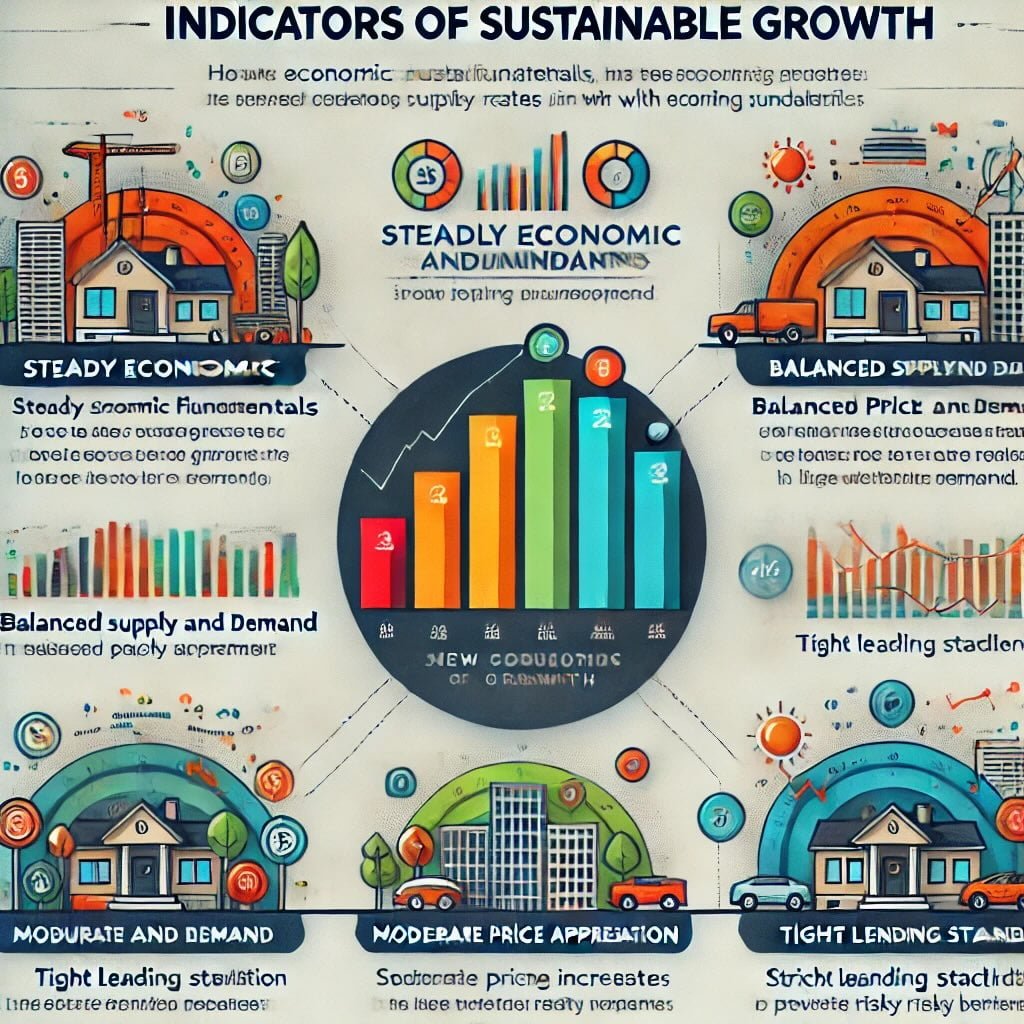
Indicators of Sustainable Growth
Steady Economic Fundamentals
Strong economic fundamentals are the bedrock of a sustainable housing market. When job growth is robust, wages are increasing, and unemployment is low, people are more financially secure and more likely to invest in homeownership. These factors contribute to a healthy demand for housing that’s grounded in real purchasing power, not speculation or easy credit.
For example, in regions where job markets are expanding—think tech hubs like Austin, Texas, or Raleigh, North Carolina—home price increases are often supported by solid economic growth. In these areas, higher wages and job security make it more feasible for people to afford homes, which can drive sustainable demand without inflating a bubble. Other economic indicators, like a rising GDP and low inflation, also signal a strong foundation for the housing market, ensuring that growth is tied to real economic progress rather than artificial factors.
Balanced Supply and Demand
A well-balanced supply and demand dynamic is key to a stable housing market. When housing supply aligns with demand, prices tend to rise at a moderate, sustainable pace. But when supply lags behind demand, prices can skyrocket, leading to potential instability. Conversely, if there’s too much supply without enough demand, prices can stagnate or even fall, which could lead to a market correction.
One way to gauge this balance is by looking at new construction rates and inventory levels. If new homes are being built at a rate that keeps up with population growth and buyer interest, the market is more likely to maintain its equilibrium. For instance, a city like Denver, where there has been consistent new construction to meet growing demand, has experienced more stable price appreciation compared to markets with tight inventory. Meeting housing demand without oversupply is crucial for preventing both the runaway price increases associated with bubbles and the downward pressure on prices that comes from a glut of available homes.
Moderate Price Appreciation
Moderate, steady price appreciation is a hallmark of sustainable housing market growth. When home prices increase gradually, it suggests that the market is growing in line with economic fundamentals, rather than being driven by speculative forces. This kind of growth is more sustainable over the long term, as it allows wages and personal incomes to catch up with rising home costs, keeping housing affordable for the majority of buyers.
Markets that have seen consistent, but not extreme, price growth are typically those where demand is strong but tempered by a sufficient supply of homes. For example, in cities like Indianapolis or Charlotte, home prices have increased at a pace that reflects steady demand and solid economic conditions, without the boom-and-bust cycles seen in more volatile markets. This moderate appreciation helps maintain affordability while still allowing homeowners to build equity over time.
Tight Lending Standards
Tight lending standards are crucial for maintaining a healthy housing market. By ensuring that only qualified buyers can secure mortgages, strict lending practices help prevent the kind of risky borrowing that led to the 2008 financial crisis. When lenders maintain high standards, such as requiring substantial down payments and thorough credit checks, they reduce the risk of defaults and foreclosures, which can destabilize the market.
Compared to the pre-2008 era, today’s lending standards are generally more stringent. For instance, the average credit score for a mortgage borrower is higher now, and there are fewer high-risk loan products available. This focus on responsible lending helps create a more stable housing market where buyers are less likely to overextend themselves, leading to more sustainable growth. However, it’s important to monitor these standards over time, as any significant loosening could signal potential risks.
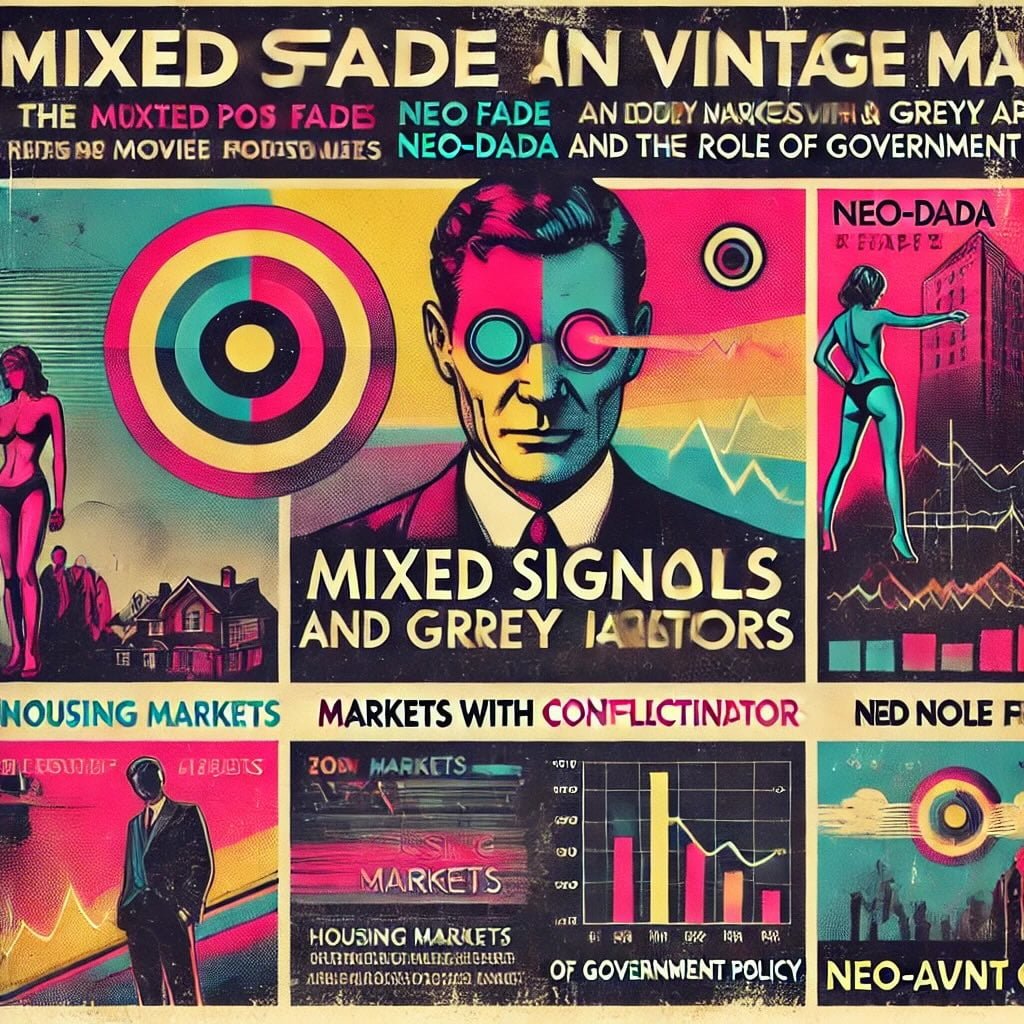
Mixed Signals and Grey Areas
Markets with Conflicting Indicators
Not all housing markets are easy to read—some send mixed signals that can be hard to decipher. In certain regions, you might see indicators that suggest a bubble, like rapid price increases or high levels of speculative buying. At the same time, other signs, such as strong economic fundamentals or balanced supply and demand, might point toward sustainable growth. These conflicting indicators can make it challenging to determine whether a market is on the brink of a downturn or simply experiencing robust, healthy growth.
Take San Francisco, for example. On one hand, the city has seen astronomical price increases and a significant amount of speculative buying, which are classic signs of a bubble. On the other hand, the tech-driven economy has created strong job growth and high wages, which could justify the elevated home prices to some extent. This combination of factors creates a grey area, where the market could either correct or continue growing, depending on how these forces play out.
Another example is Miami, where the real estate market has experienced significant price appreciation, driven partly by an influx of out-of-state buyers and investors. While some might view this as a bubble, Miami’s growing population, strong demand for housing, and limited supply suggest that the market could continue to thrive. However, the high levels of investor activity raise concerns about the market’s sustainability, especially if economic conditions change.
The Role of Government Policy
Government policy plays a significant role in shaping the housing market, often blurring the lines between a bubble and sustainable growth. Interventions such as stimulus packages, tax incentives, or housing subsidies can inject liquidity into the market, driving up demand and, consequently, prices. While these measures can provide short-term relief or stimulate growth, they can also lead to unintended consequences.
For instance, during the COVID-19 pandemic, many governments around the world implemented stimulus packages and lowered interest rates to support their economies. These actions helped keep housing markets afloat during uncertain times but also contributed to a surge in home prices as borrowing became cheaper and more people entered the market. In some cases, these policies may have exacerbated price increases, potentially inflating bubbles in certain regions.
Another example is the first-time homebuyer tax credits that were introduced in several countries to encourage homeownership. While these incentives made it easier for people to buy homes, they also increased demand in already tight markets, pushing prices even higher. In the long run, such policies can create distortions in the market, leading to price corrections when the incentives are removed or when interest rates rise.
The challenge with government policy is that it often has to balance short-term economic goals with long-term market stability. While policies aimed at stimulating the housing market can provide immediate benefits, they can also create vulnerabilities if not carefully managed. As an investor or potential homeowner, it’s important to stay aware of how government interventions might be influencing your local housing market and to consider the potential risks and rewards.

What to Watch in the Coming Months
Interest Rate Changes
Interest rates are one of the most significant factors to watch in the housing market. When rates are low, borrowing becomes cheaper, which can drive up demand for homes and push prices higher. However, when interest rates rise, the cost of borrowing increases, which can cool down demand and lead to a slowdown in price appreciation—or even a decline in home prices.
In the coming months, many experts are predicting potential interest rate hikes as central banks look to combat inflation. For instance, the Federal Reserve has already signaled that rate increases could be on the horizon, which could significantly impact the housing market. If rates go up, we might see a decrease in buyer activity, as higher mortgage costs make homeownership less affordable for many. This could lead to a softening of prices, especially in markets that have experienced rapid appreciation.
Experts like Mark Zandi, chief economist at Moody’s Analytics, suggest that even a modest increase in interest rates could cool down some of the overheated markets. However, others argue that the impact might be muted if economic growth remains strong and wages continue to rise, offsetting the higher borrowing costs.
Economic Indicators to Monitor
Keeping an eye on key economic indicators can provide valuable insights into where the housing market might be headed. Here are some of the most critical indicators to watch:
- GDP Growth: A strong GDP often correlates with a healthy housing market, as it reflects overall economic strength. If GDP growth slows, it could signal potential challenges for the housing market.
- Unemployment Rates: Low unemployment typically supports housing demand, as more people are financially stable and able to buy homes. Conversely, rising unemployment could lead to a decrease in demand.
- Inflation: High inflation can erode purchasing power and increase the cost of living, which might dampen housing market activity. Additionally, persistent inflation could prompt central banks to raise interest rates, further impacting the market.
- Consumer Confidence: This indicator reflects how optimistic or pessimistic consumers are about the economy’s future. High confidence often leads to more home buying, while low confidence can signal a potential slowdown.
By tracking these indicators, you can get a better sense of the broader economic environment and how it might affect housing market trends.
Market Sentiment
Market sentiment is another critical factor to watch as it can significantly influence housing market dynamics. Right now, sentiment among buyers, sellers, and investors appears to be mixed. On one hand, there’s still a strong demand for homes, driven by low mortgage rates and a desire for more space as remote work continues. On the other hand, concerns about affordability, potential interest rate hikes, and the sustainability of recent price increases are causing some caution.
If sentiment shifts significantly—whether due to economic news, changes in interest rates, or other factors—it could have a substantial impact on the market. For example, if buyers start to feel that prices have peaked, we might see a pullback in demand, leading to slower price growth or even declines in some areas. Conversely, if sentiment remains optimistic, we could see continued strong demand and further price appreciation.
Investors, in particular, are closely watching these dynamics. If they sense that the market is overheated, they might start to pull back, which could lead to a cooling off in speculative buying and a return to more sustainable price levels. On the flip side, if investors remain bullish, they could continue driving up prices in certain markets.
12-Question FAQ: Housing Bubble or Sustainable Growth? Key Indicators to Watch
1) What’s the simplest definition of a housing bubble?
A rapid price surge detached from fundamentals (incomes, rents, yields) and fueled by easy credit and speculation. It ends when financing tightens or sentiment flips.
2) How is sustainable growth different?
Prices rise moderately in step with wages, rents, and productivity; lending stays prudent; inventory and construction roughly match household formation.
3) Which “red-flag” indicators point to a bubble?
Price growth far above local income/rent growth
Credit expanding faster than GDP
Investor/flipper share surging
Lax underwriting (high LTV, low documentation)
Price-to-income and price-to-rent ratios at extremes
4) What signals healthy, durable growth?
Job and wage gains leading or matching price gains
Stable or improving affordability metrics
Balanced months of supply (≈4–6 in many markets)
Tight but fair lending (DTI/LTV caps, stress tests)
Construction aligned with demand, not speculative overbuild
5) How important are interest rates?
Very. Low rates boost purchasing power and prices; rising rates cool demand. Watch mortgage rates vs. wage growth and the share of adjustable-rate loans.
6) Which affordability metrics should I track?
Price-to-income (PTI) vs. local history
Payment-to-income (mortgage + taxes/insurance) at current rates
Rent-to-price (cap rate / implied yield) vs. bond yields
7) What do supply metrics tell us?
Months of supply: <3 = overheating risk; >6 = softening.
New listings & completions vs. household formation: persistent deficits push prices; gluts precede corrections.
8) How do investor and flipper shares affect risk?
Rising investor/flipper activity adds volatility. If investors dominate marginal demand, a sentiment shift can trigger sharp pullbacks.
9) Are lending standards loosening?
Track average LTV/DTI, credit scores at origination, interest-only/ARMs share, and exception underwriting. Looser standards often precede stress.
10) Which macro indicators matter most?
Employment growth, unemployment trend, inflation (and central-bank reaction), GDP growth, and consumer confidence—these steer rates and housing demand.
11) What are “tipping-point” signs?
Bid-ask spreads widening, days-on-market jumping, price cuts accelerating, cancellations rising, and absorption rates falling—often early in a cool-down.
12) How can buyers/investors protect themselves?
Stress-test payments at higher rates, avoid over-leverage, prioritize cash-flow (for rentals), keep liquidity buffers, and buy with long horizons in diverse, employment-rich areas.
Educational content only; not financial advice.
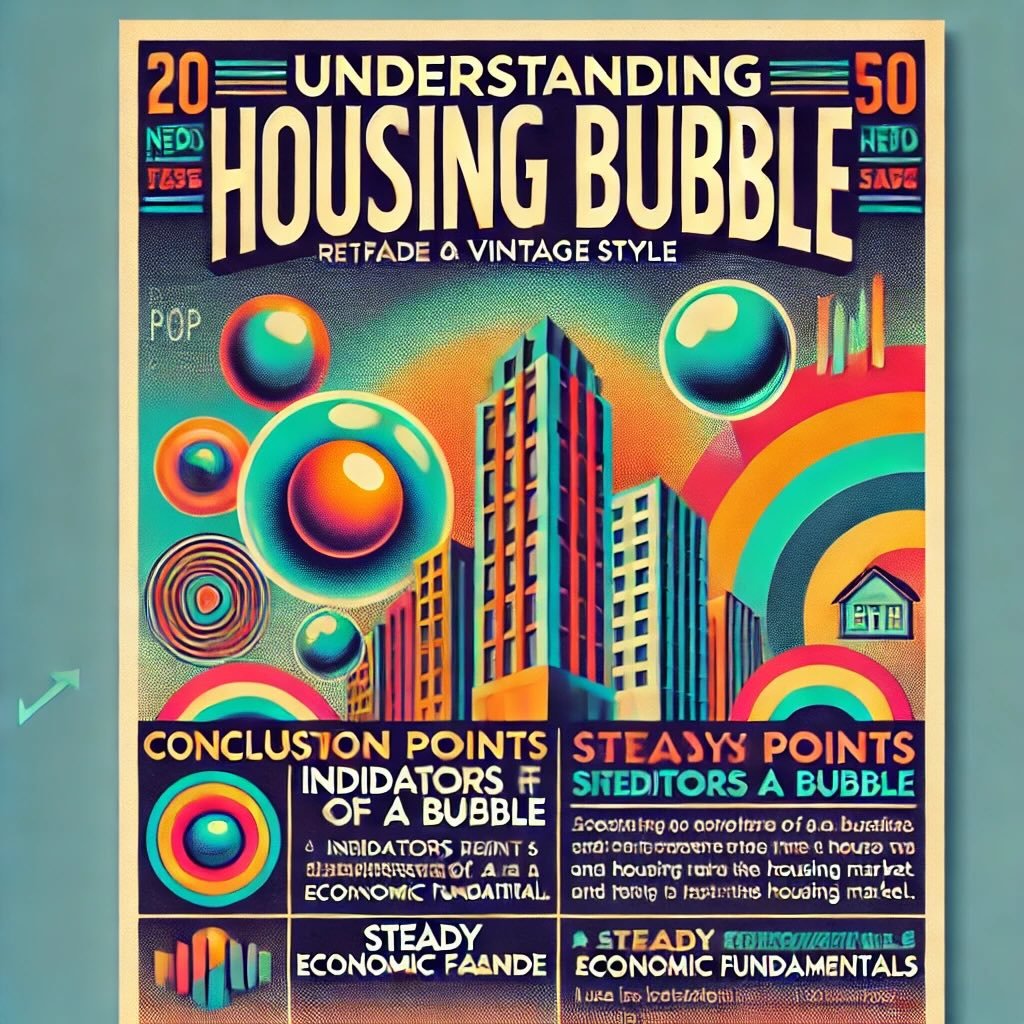
Conclusion
Rapid price increases, low interest rates, high levels of speculation, rising mortgage debt, and lax lending standards are all indicators that could point to a housing bubble. On the flip side, steady economic fundamentals, a balanced supply and demand dynamic, moderate price appreciation, and tight lending standards suggest that the market may be on solid footing, growing at a sustainable pace.
Encouragement to Stay Informed
In today’s fast-paced housing market, staying informed is more crucial than ever. The landscape can change rapidly, influenced by everything from interest rate shifts to economic policy decisions. By keeping a close eye on the key indicators we’ve discussed, you can better navigate the market’s twists and turns. Whether you’re looking to buy, sell, or invest, knowledge is your best tool for making smart decisions. Keep up with the latest data, watch market trends, and be ready to adapt as conditions evolve.
Final Thoughts
The current housing market is a mix of risks and opportunities. While some areas may be showing signs of a bubble, others are growing steadily and sustainably. The key is to approach the market with a critical eye, recognizing both the potential pitfalls and the possibilities. As we move forward, staying vigilant and informed will help you make the most of the opportunities while avoiding unnecessary risks. The housing market is always evolving, and with the right knowledge and strategy, you can position yourself for success in any market condition.
Important Information
Comprehensive Investment Disclaimer:
All content provided on this website (including but not limited to portfolio ideas, fund analyses, investment strategies, commentary on market conditions, and discussions regarding leverage) is strictly for educational, informational, and illustrative purposes only. The information does not constitute financial, investment, tax, accounting, or legal advice. Opinions, strategies, and ideas presented herein represent personal perspectives, are based on independent research and publicly available information, and do not necessarily reflect the views or official positions of any third-party organizations, institutions, or affiliates.
Investing in financial markets inherently carries substantial risks, including but not limited to market volatility, economic uncertainties, geopolitical developments, and liquidity risks. You must be fully aware that there is always the potential for partial or total loss of your principal investment. Additionally, the use of leverage or leveraged financial products significantly increases risk exposure by amplifying both potential gains and potential losses, and thus is not appropriate or advisable for all investors. Using leverage may result in losing more than your initial invested capital, incurring margin calls, experiencing substantial interest costs, or suffering severe financial distress.
Past performance indicators, including historical data, backtesting results, and hypothetical scenarios, should never be viewed as guarantees or reliable predictions of future performance. Any examples provided are purely hypothetical and intended only for illustration purposes. Performance benchmarks, such as market indexes mentioned on this site, are theoretical and are not directly investable. While diligent efforts are made to provide accurate and current information, “Picture Perfect Portfolios” does not warrant, represent, or guarantee the accuracy, completeness, or timeliness of any information provided. Errors, inaccuracies, or outdated information may exist.
Users of this website are strongly encouraged to independently verify all information, conduct comprehensive research and due diligence, and engage with qualified financial, investment, tax, or legal professionals before making any investment or financial decisions. The responsibility for making informed investment decisions rests entirely with the individual. “Picture Perfect Portfolios” explicitly disclaims all liability for any direct, indirect, incidental, special, consequential, or other losses or damages incurred, financial or otherwise, arising out of reliance upon, or use of, any content or information presented on this website.
By accessing, reading, and utilizing the content on this website, you expressly acknowledge, understand, accept, and agree to abide by these terms and conditions. Please consult the full and detailed disclaimer available elsewhere on this website for further clarification and additional important disclosures. Read the complete disclaimer here.




